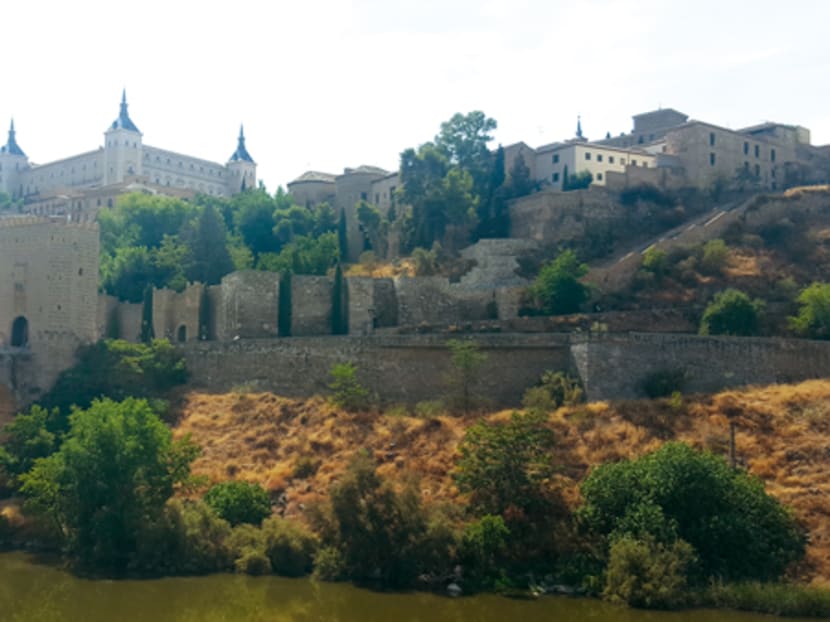Heritage city and gastronomic capital
Most tourists come to Toledo, Spain, on a day trip from Madrid. But this small Unesco World Heritage city, famed for its marzipan, swords and monuments, has plenty to keep a curious traveller occupied for more than a couple of days, whether you are a history buff, foodie, souvenir hunter or art fan.

Toledo is a former capital of the Spanish Empire. PHOTO: Tan Chui Hua
Most tourists come to Toledo, Spain, on a day trip from Madrid. But this small Unesco World Heritage city, famed for its marzipan, swords and monuments, has plenty to keep a curious traveller occupied for more than a couple of days, whether you are a history buff, foodie, souvenir hunter or art fan.
CITY OF THREE CULTURES
Throughout history, Toledo has held an important place in the hearts of its conquerors — from the Romans to the Visigoths, Arabs and Spaniards. This rich confluence of cultures is traceable today in Toledo’s architecture, layout and delectable cuisine.
Toledo’s moniker, “City of Three Cultures”, refers to the rare period in its history where Jewish, Christian and Muslim communities lived and worked together peaceably under Arabic rule.
The most poignant Arabic imprint on Toledo is in the layout and urban sensibility of the city — from the winding alleys and streets to the inner courtyards featuring fountains and gardens influenced by Moorish design.
The cultural legacy of the Arabs, who ruled Toledo for three centuries, is also evident in the ubiquitous Moorish windows, and well- preserved former mosques.
As a former capital of the Spanish Empire, Toledo also has many Spanish monuments among its lot.
The 13th-century Primate Cathedral of Saint Mary of Toledo, located in the heart of the old district, is not to be missed.
One of the best examples of the Gothic style in Spain, the Cathedral’s intricate carvings — with its biblical and historical scenes, play of light and structure, and stained glass windows — easily require a few hours to soak in.
For a sweeping view of the historic district, take a short walk up to Mirador del Valle.
From this vantage point, it becomes clear how Toledo’s geography helped defend the city in the past: Its rivers and rocky outcrops provided natural barriers against attacks.
A PLAYGROUND FOR MUSEUM HOPPERS
If your idea of a holiday is visiting a cluster of museums within walking distance, Toledo is your answer. Here, there are easily over 10 museums and galleries. If art is your thing, visit Museo del Greco, dedicated to Domenikos Theotokopoulos, better known as El Greco (The Greek). The period artefacts and paintings give you a good idea of the 16th century painter-architect-sculptor’s works and life.
Are history and heritage more your style? Dig into the exhibits at the two museums on Jewish culture and another on Toledo’s Visigoth history.
For those who like museums that focus on more niche topics, the Museo de la Tortura focuses on Spanish torture instruments, the Museo de la Espana Magica displays magical artefacts and there’s even a Cheese Museum.
PARTRIDGE, MAZAPAN AND MANCHEGO CHEESE
Toledo’s food scene demands some serious attention.
Toledo was Spain’s Capital of Gastronomy in 2016 and the city’s marzipan — Mazapan de Toledo — is so famed that it enjoys Protected Geographical Indication status, which protects the reputation of the regional foods and prevents consumers from being misled by non-genuine products.
Manchego cheese, made from the milk of the Manchega sheep, is another Toledo delicacy.
For more filling sustenance, Toledo has a number of memorable local specialties.
The partridge is featured in two well-known dishes — partridge stew (served hot or cold); and partridge pate. The latter is a rich composition of partridge, pork and herbs, baked to perfection and covered with bay leaves and slices of bacon.
MEDIEVAL MAGIC
Fans of medieval lore and artefacts will have a field day.
The city has a long tradition of forging swords and is known for its high-quality steel and metal work, so much so that it became the source of weaponry for Roman legions.
Today, you can still see metal forging in Toledo’s factories.
And if your wallet permits, Toledo’s best keepsake is probably a slice of its history — in the form of a beautifully crafted Toledo steel knife.
TRAVEL TIPS:
Getting there
Take a 25-minute ride on the high-speed train from Madrid. The first train departs from Madrid’s Atocha Station at 6.50am, and the last train leaves Toledo at 9.30pm.





